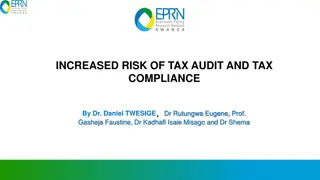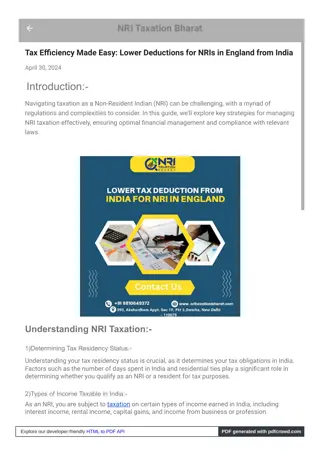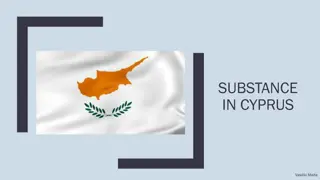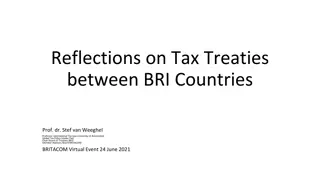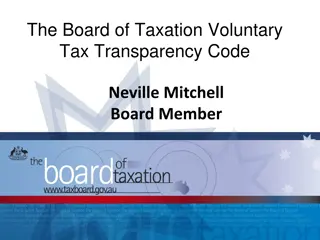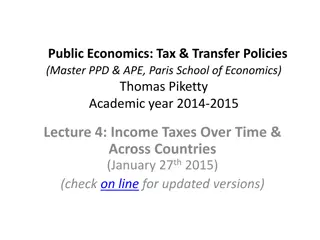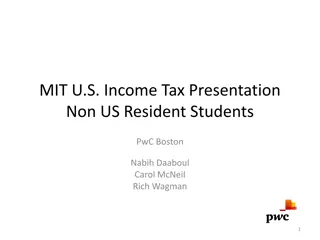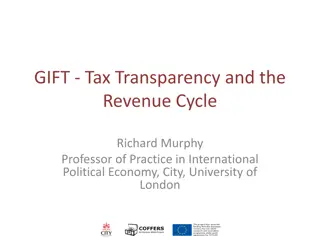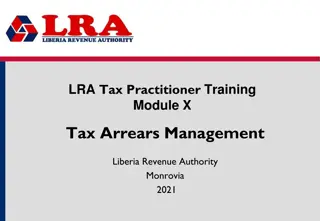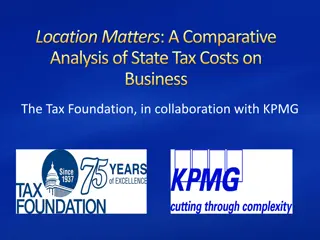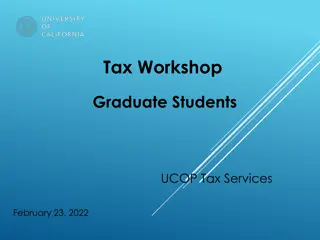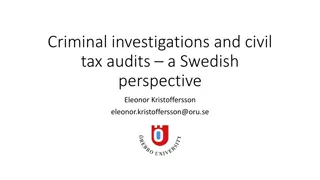Strategies in Negotiating a Tax Compact
This content delves into strategies for negotiating a tax compact, covering types of state and municipal taxes, considerations in negotiations, and the implications of tax imposition on various entities. It explores the complexities of tax burdens, economic factors, and governmental responsibilities in tax negotiations.
Download Presentation

Please find below an Image/Link to download the presentation.
The content on the website is provided AS IS for your information and personal use only. It may not be sold, licensed, or shared on other websites without obtaining consent from the author.If you encounter any issues during the download, it is possible that the publisher has removed the file from their server.
You are allowed to download the files provided on this website for personal or commercial use, subject to the condition that they are used lawfully. All files are the property of their respective owners.
The content on the website is provided AS IS for your information and personal use only. It may not be sold, licensed, or shared on other websites without obtaining consent from the author.
E N D
Presentation Transcript
Strategies in Negotiating a Tax Compact
Type of Taxes Matter Common State Taxes Cigarette Excise tax Contractor s Excise Tax Use Taxes Utility Taxes Fuel Taxes Amusement and Vending Device Taxes Tourism Taxes Telecommunications Taxes Energy Taxes (Oil/Gas, Solar, extractive industries, fuels, etc.) OTHER What States are Not Compacting on and for which state laws are not providing a mechanism to negotiate. Municipal Taxes Municipal Use Tax County taxes Wheel Tax
Who Imposes the Tax Matters and What State Law Says Matter I. Who bears the legal burden of the Tax (business sales taxes) or the consumer (use taxes) or the vendor (gross receipts taxes) II. Who bears the economic burden of the Tax matters (most gross receipts taxes can be passed on to the entity paying the tax. Example: contractors excise taxes usually can be passed on to a Tribe as owner although they are paid to the State by the contractor. - See, in contrast Everi Payments, Inc. v. Washington Department of Revenue, 6 Wash. App.2d 580 (Wa, 2018), Review denied 193 Wash.2d 1014 (June 5, 2019)(B&O tax was not passed on to the Tribal casino)
Starting Point: What Does the State Consider in Negotiating Population Data Adjustments to Population based on data from other sources Population Growth Expected based on birth and death rates (Indian Health Service User data, Census Population age informaiton) Economic Burden who is providing the services? Governmental Burden - Poverty What should a state consider? Who has the authority to impose the tax tribally owned businesses and entities. Who is providing on-reservation services to the entity or person taxed where the tax is occurring? (roads, police, fire, etc.) The economic benefit to the State of the activity taxed with tribally owned business and activities The economic multiplier effects of the local economy of the Tribe s use of taxes collected
Starting Point: What does the State Use the Taxes for and What does the Tribe uses the taxes for White Mountain Apache v. Bracker 448 U.S. 136 (1980) Balancing Test that outlines how a State to have tax authority in Indian Country must demonstrate that the tax imposed bears a relationship to the services provided at the expense of the state. Bracker observed that Congress broad constitutional power to regulate tribal affairs and the position of Indian tribes as a separate people have given rise to two independent but related barriers to the assertion of state regulatory authority over tribal reservations and members. First, the exercise of such authority may be pre-empted by federal law. Second, it may unlawfully infringe on the right of reservation Indians to make their own laws and be ruled by them. Bracker at 142 When a state tax falls on a non-Indian in Indian country and Congress has not expressly allowed (or prohibited) the tax, the Court uses Bracker balancing to determine whether the state can overcome the presumption by demonstrating that the taxation advances the state s legitimate interests while not unduly burdening those of the tribe and the federal government. Bracker at 150- 51. It is a particularized inquiry into the nature of the state, federal, and tribal interests at stake[.] Bracker at 145.
Starting Point: What does the State Use the Taxes for and What the Tribe uses the taxes for The inquiry examines relevant federal treaties and statutes in terms of both the broad policies that underlie them and the notions of sovereignty that have developed from historical traditions of tribal independence. Id. at 144-45. It also gives weight to any applicable regulatory interest of the State, id. at 144, identified in Bracker as government functions [the state] performs for those on whom the taxes fall, or a legitimate regulatory interest served by the taxes [the state] seek[s] to impose, id. at 150. A general desire to raise revenue alone is insufficient. Id. - If a State cannot demonstrate the services it provides on reservation are funded by the taxes imposed, it should not have authority to tax. Taxes are a revenue raising mechanism to pay for services provided when it comes to Indian country. They should not be for the purpose of a windfall to states to provide services to off reservation populations. For this reason, where the tribe shows the taxes it collects are used to provide services to the communities taxed, and the state does not show likewise, this is a rational reason to increase the tribal percentage of tax under a compact. -
Census Data Strategies - Population Population Statistics and Facts - Census undercount is always 4.9 percent undercount in rural areas. Hard to Count Census Tracts: https://www.census.gov/newsroo m/releases/archives/2010_census/ cb12-95.html - School enrollment Data - Tribal enrollment data - IHS User Population Data Population Growth - Population Structure young populations are growing - exponential population growth. - In most rural areas the Caucasian Populations are declining and aging while in most tribal communities populations are growing - Median Age based on race data - School enrollment data - Birth and Death rates
Who is Providing the Service? Governmental Burden Common Areas to Discuss Roads road miles and road expenditures Services Courts Social support expenditures Law Enforcement Telecommunications Water Education Government infrastructure and buildings and services where the state has no on reservation services in an area. Cases: White Mountain Apache v. Bracker, Confederated Tribes of Chehalis Reservation v. Thurston County Board of Equalization 724 F.3d 1153 (9thCir. 2013)
Poverty and Governmental Burden Governmental Burden Poverty by Race Statistics Social Service case numbers Low Income Housing population counts Employment data Census and Department of Labor Who is the largest employer?
A New Discussion: Tax Parity Why Beggar thy Indian Neighbor: The Case for Tribal Tax Primacy in Taxation in Indian Countryhttp://nni.arizona.edu/application/files/ 8914/6254/9090/2016_Croman_why_beggar_t hy_Indian_neighbor.pdf Tribal government as a large employer in the area is responsible for providing the source of income for its residents who then buy goods and services off reservation States collect ALL taxes on Indian country residents off-reservation. But it is the Tribe that pays for and provides the services to those residents. This creates an inequitable burden on tribal governments. It also creates inequity for residents in Indian country the government providing the services is not the government receiving their tax payments which in turn ensures reduced improvement in services they receive in their communities. See Minnesota Laws which provide for Tax Parity.
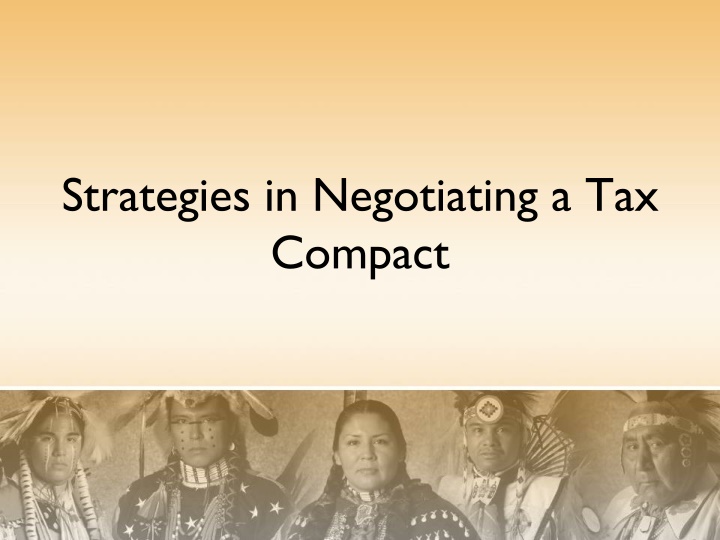


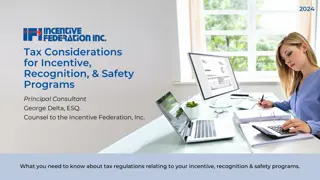
![Town of [Town Name] Real Estate Tax Rates and FY 2024 Budget Summary](/thumb/62211/town-of-town-name-real-estate-tax-rates-and-fy-2024-budget-summary.jpg)
